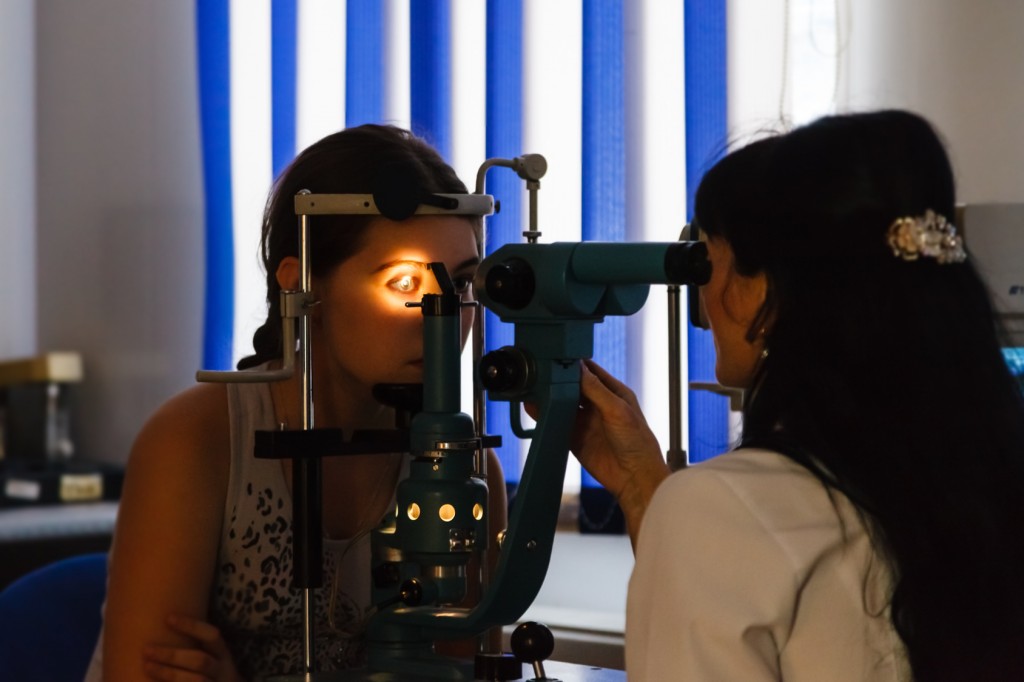Between 500 and 600 cases of eye cancer (ocular cancer) are diagnosed in the UK each year.
There are a number of different types of cancer that affect the eyes, including:
eye melanoma
squamous cell carcinoma
retinoblastoma – a childhood cancer
Cancer can also sometimes develop in the tissues surrounding your eyeball or spread to the eye from other parts of the body, such as the lungs or breasts.
This topic focuses on melanoma of the eye, one of the most common types of eye cancer. The Cancer Research UK website has more information about the other types of eye cancer.
Symptoms of eye cancer
Eye cancer doesn’t always cause obvious symptoms and may only be picked up during a routine eye test.
Symptoms of eye cancer can include:
shadows, flashes of light, or wiggly lines in your vision
blurred vision
a dark patch in your eye that’s getting bigger
partial or total loss of vision
bulging of one eye
a lump on your eyelid or in your eye that’s increasing in size
pain in or around your eye, although this is rare
These symptoms can also be caused by more minor eye conditions, so they’re not necessarily a sign of cancer. However, it’s important to get the symptoms checked by a doctor as soon as possible.
Melanoma of the eye
Melanoma is cancer that develops from pigment-producing cells called melanocytes. Most melanomas develop in the skin, but it’s also possible for them to occur in other parts of the body, including the eye.
Eye melanoma most commonly affects the eyeball. Doctors sometimes call it uveal or choroidal melanoma, depending on exactly which part of your eye is affected.
It can also affect the conjunctiva, the thin layer that covers the front of the eye, or the eyelid.
What causes eye melanoma?
Eye melanoma occurs when the pigment-producing cells in the eyes divide and multiply too rapidly. This produces a lump of tissue known as a tumour.
It’s not clear exactly why this occurs, but the following factors may increase the risk of it happening:
lighter eye colour – if you have blue, grey or green eyes, you have a higher risk of developing eye melanoma compared with people who have brown eyes
white or pale skin – eye melanoma mostly affects white people and is more common in those with fair skin
unusual moles – if you have irregularly shaped or unusually coloured moles, you’re more at risk of developing skin cancer and eye melanoma
use of sunbeds – there’s some evidence to suggest that exposing yourself to ultraviolet (UV) radiation from sunbeds, for example, can increase your risk of eye melanoma
overexposure to sunlight – this increases your risk of skin cancer, and may also be a risk factor for eye melanoma
The risk of developing eye melanoma also increases with age, with most cases being diagnosed in people in their 50s.
Read about the risk factors for other types of eye cancer on the Cancer Research UK website.
Diagnosing melanoma of the eye
If your GP or optician (optometrist) suspects you have a serious problem with your eyes, they will refer you to a specialist eye doctor called an ophthalmologist for an assessment.
If they suspect you have melanoma of the eye, they’ll refer you to a specialist centre for eye cancer. There are four centres in the UK, located in London, Sheffield, Liverpool, and Glasgow.
It’s likely you’ll have a number of different tests at the centre, including:
an eye examination – to look at the structures of your eyes in more detail and check for abnormalities
an ultrasound scan of your eye – a small probe placed over your closed eye uses high-frequency sound waves to create an image of the inside of your eye; this allows your doctor to find out more about the position of the tumour and its size
a fluorescein angiogram – where photographs of the suspected cancer are taken using a special camera after dye has been injected into your bloodstream to highlight the tumour
Occasionally, a thin needle may be used to remove a small sample of cells from the tumour (biopsy). The genetic information in these cells is analysed to give an indication of the chances of the cancer spreading or coming back.
Treatments for eye melanoma
Treatment for melanoma of the eye depends on the size and location of the tumour. Your care team will explain each treatment option in detail, including the benefits and any potential complications.
Treatment will aim to conserve the affected eye whenever possible.
The main treatments for eye melanoma are:
brachytherapy – tiny plates lined with radioactive material called plaques are inserted near the tumour and left in place for up to a week to kill the cancerous cells
external radiotherapy – a machine is used to carefully aim beams of radiation at the tumour to kill the cancerous cells
surgery to remove the tumour or part of the eye – this may be possible if the tumour is small and you still have some vision in your eye
removal of the eye (enucleation) – this may be necessary if the tumour is large or you’ve lost your vision; the eye will eventually be replaced with an artificial eye that matches your other eye
Chemotherapy is rarely used for eye melanoma, but may be suitable for other types of eye cancer.
The Cancer Research UK website has more information about the treatment options for eye cancer and the types of eye cancer surgery.
Outlook for eye melanoma
The outlook for melanoma of the eye depends on how big the cancer is at the time it’s diagnosed and exactly which parts of the eye are affected.
Overall:
about 8 out of every 10 people (80%) diagnosed with a small eye melanoma will live for at least five years after diagnosis
about 7 out of every 10 people (70%) diagnosed with a medium-sized eye melanoma will live for at least five years after diagnosis
about 5 out of every 10 people (50%) diagnosed with a large eye melanoma will live for at least five years after diagnosis
The Cancer Research UK website has more information about the stages of eye cancer and statistics and outlook for eye cancer.

